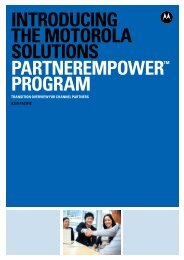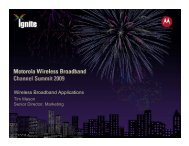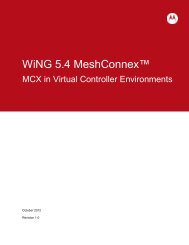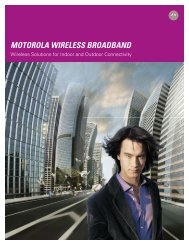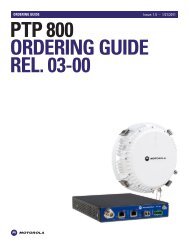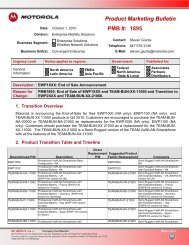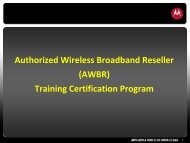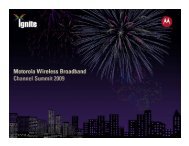Supplement to the Canopy System Release 8 User Guide PMP 400
Supplement to the Canopy System Release 8 User Guide PMP 400
Supplement to the Canopy System Release 8 User Guide PMP 400
You also want an ePaper? Increase the reach of your titles
YUMPU automatically turns print PDFs into web optimized ePapers that Google loves.
<strong>PMP</strong> <strong>400</strong> and PTP 200 Series<strong>Canopy</strong> <strong>User</strong> <strong>Guide</strong> <strong>Supplement</strong>Radiated Power). This is different than <strong>the</strong> 30 dBm EIRP allowed for <strong>Canopy</strong> FSK modulesoperating in <strong>the</strong> 5.4 GHz band because <strong>the</strong> regulations are for spectral power density and withhalf <strong>the</strong> channel size (10 MHz vs 20 MHz), <strong>PMP</strong> <strong>400</strong> and PTP 200 Series radios are allowed half<strong>the</strong> power (27 dBm vs 30 dBm).To meet 27 dBm EIRP with <strong>the</strong> connec<strong>to</strong>rized 18 dBi antenna (with 1 dB of cable loss) thatcomes with <strong>the</strong> 5440AP or 5441AP, or <strong>the</strong> integrated 17 dBi antenna that comes with a 5440BHor 5441BH, <strong>the</strong> maximum setting allowed is 10 dBm (<strong>the</strong> default) since 27-17=10.If a connec<strong>to</strong>rized AP or BHM has been purchased and <strong>the</strong> opera<strong>to</strong>r has provided <strong>the</strong> antenna,<strong>the</strong> Transmitter Output Power must be configured based on that antenna and consistent withlocal or regional regulations. For example, if a 5440APC is being used with a 12 dBi antenna,<strong>the</strong>n <strong>the</strong> maximum setting allowed <strong>to</strong> meet 27 dBm EIRP is <strong>the</strong> full 15 dBm of which <strong>the</strong> radio iscapable, since 27-12=15.IMPORTANT!It is <strong>the</strong> responsibility of <strong>the</strong> opera<strong>to</strong>r and professional installer <strong>to</strong> ensureTransmitter Output Power is set within regula<strong>to</strong>ry limits for <strong>the</strong>ir countryor region. These must be set or confirmed on initial configuration andafter a module is reset <strong>to</strong> fac<strong>to</strong>ry defaults, and should be confirmed after<strong>the</strong> software on a module is upgraded.In most cases, <strong>the</strong> opera<strong>to</strong>r will want <strong>to</strong> set <strong>the</strong> AP’s Transmitter Output Power <strong>to</strong> <strong>the</strong> maximumallowed so as <strong>to</strong> have <strong>the</strong> greatest overall range and <strong>the</strong> greatest range for 3X operation. It maybe useful <strong>to</strong> reduce Transmitter Output Power when <strong>Canopy</strong> systems are located close <strong>to</strong>ge<strong>the</strong>r,with good coverage given because of <strong>the</strong>ir proximity and full power isn’t needed, or in caseswhere an opera<strong>to</strong>r is trying <strong>to</strong> reduce interference from <strong>the</strong> <strong>Canopy</strong> system <strong>to</strong> o<strong>the</strong>r systems.Each SM’s Transmitter Output Power is au<strong>to</strong>matically set by <strong>the</strong> AP, not by <strong>the</strong> opera<strong>to</strong>r. TheAP’s Au<strong>to</strong>-TPC (Transmit Power Control) sets each SM’s Transmitter Output Power <strong>to</strong> <strong>the</strong> lesserof• 10 dBm for a 5.4 GHz radio, <strong>the</strong> maximum allowed on <strong>the</strong> SM since it has anintegrated 17 dBi antenna and a regula<strong>to</strong>ry maximum EIRP of 27 dBm (27-17=10)• 18 dBm for a 4.9 GHz radio• a power level so that <strong>the</strong> received power at <strong>the</strong> AP from that SM is not greater than60 dBm.<strong>PMP</strong> <strong>400</strong> Series networks use Au<strong>to</strong>-TPC because OFDM technology is more sensitive <strong>to</strong> largedifferences in power levels from SMs operating at various distances from <strong>the</strong> AP than <strong>the</strong> singlecarrier technology used in <strong>Canopy</strong> FSK.PTP 200 Series networks do not use Au<strong>to</strong>-TPC – <strong>the</strong> opera<strong>to</strong>r sets Transmitter Output Power on<strong>the</strong> “Configuration => Radio” page of both <strong>the</strong> BHM and <strong>the</strong> BHS.<strong>PMP</strong> <strong>400</strong> and PTP 200 Series modules display <strong>the</strong> typical <strong>Canopy</strong> “Receive Power Level” butdue <strong>to</strong> <strong>the</strong> different modulation technique no “jitter” is calculated or displayed.4.3 DOWNLINK DATA %, RANGE, AND CONTROL SLOTSThe Downlink Data % parameter on <strong>the</strong> AP’s and BHM’s “Configuration => General” page can beset in 1% increments between 10% and 90%. (Standard <strong>Canopy</strong> can be set between 1% and99%, although internal calculations don’t result in that extreme of slot assignment between uplinkand downlink.) The default is 75%, <strong>the</strong> same as standard <strong>Canopy</strong>.Issue 3, January 2009 Page 19 of 45







